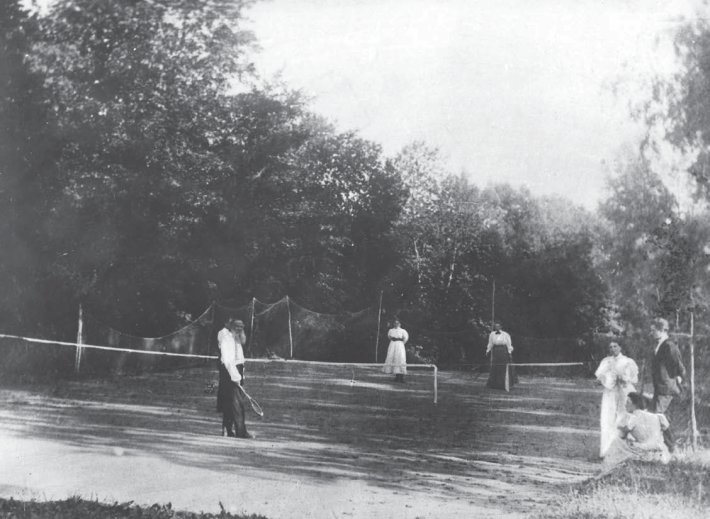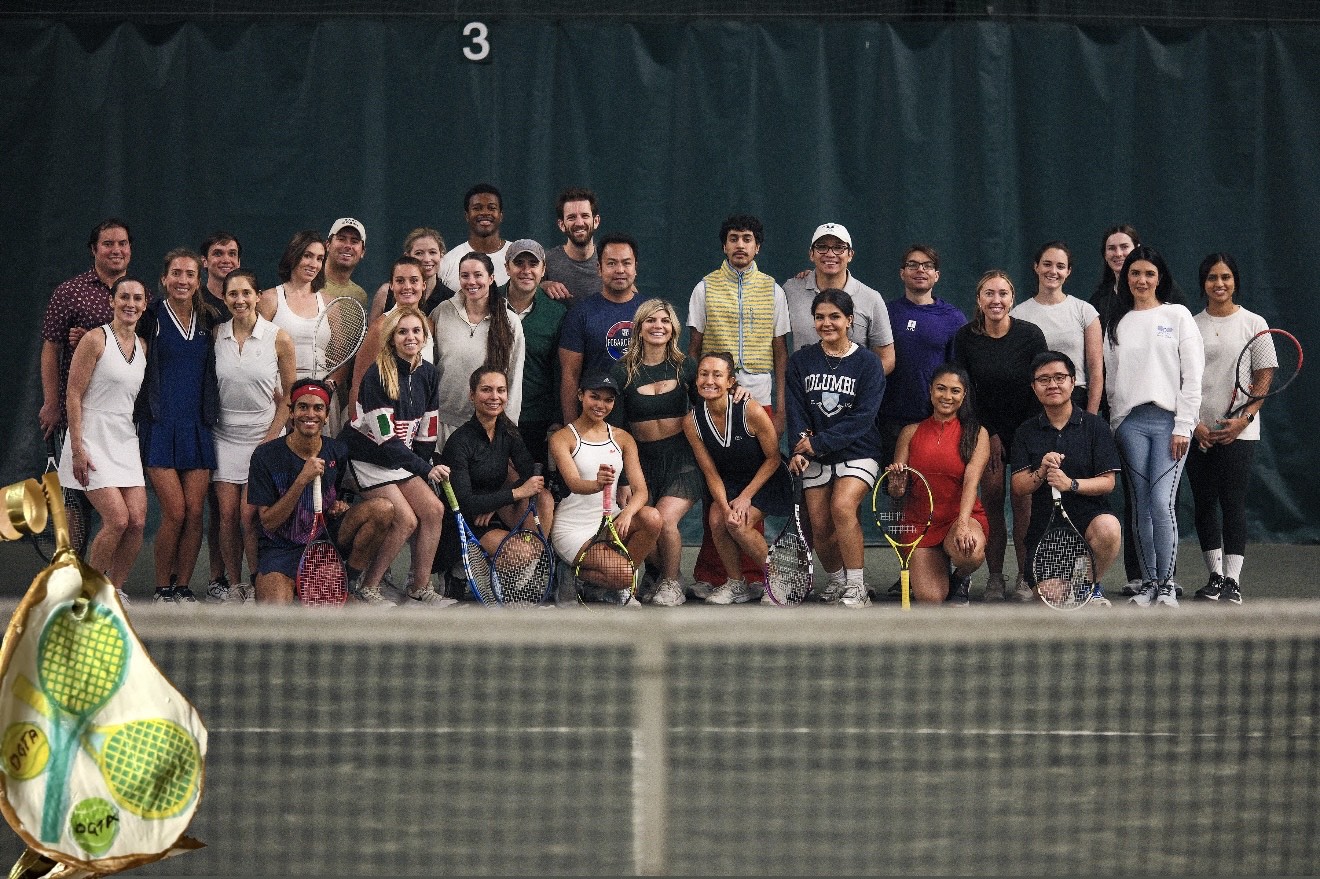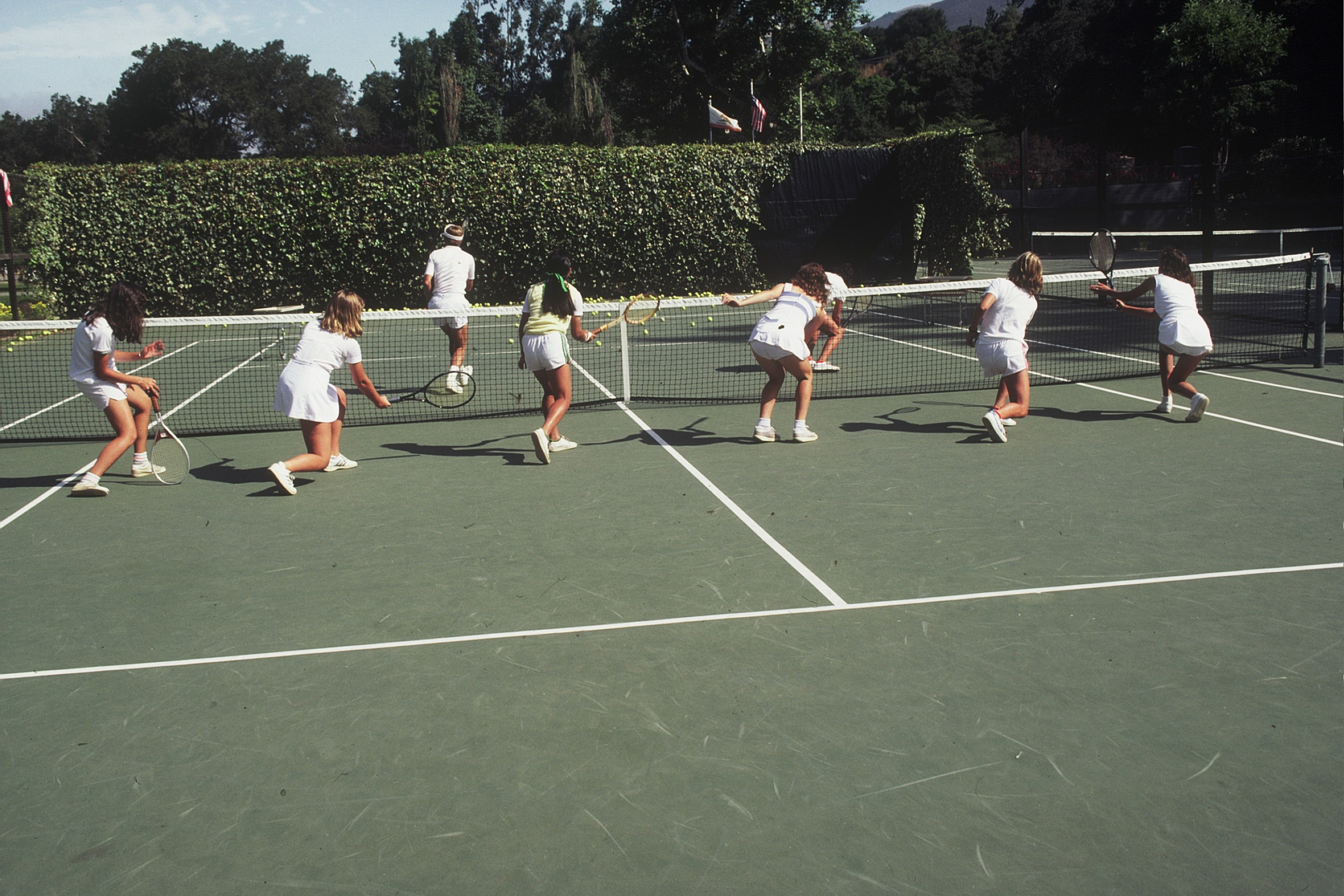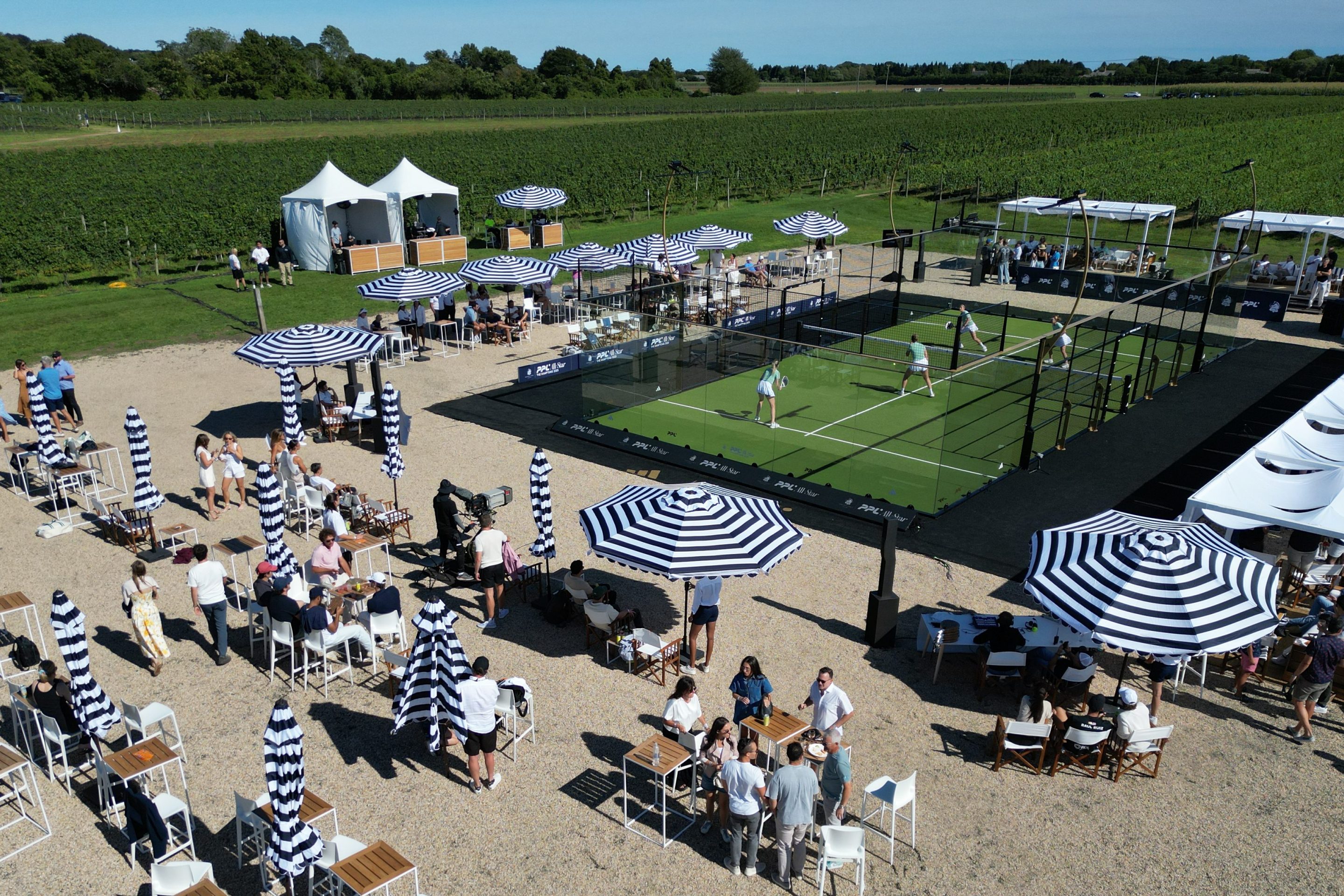Illustration by Joan LeMay
Though the revelation that onetime ATP world No. 8 and major Schopenhauer fan Janko Tipsarevic had a quote from Dostoyevsky’s The Idiot tattooed on his bicep once unleashed a firestorm of slightly patronizing excitement among tennis commentators, the marriage between the Great Russian Novel and tennis is a time-honored and complicated relationship, stretching from the 1870s, when Tolstoy wrote about tennis in Anna Karenina, through the 20th century, when Nabokov made the game a central obsession in Lolita.
In his English-language masterpiece, Nabokov—who was a fine player himself, and supported himself as a young writer and recent émigré by teaching tennis in Europe— returns over and over again to the game. Throughout Lolita, there are 36 references to tennis, not counting two additional references to backhand slaps, and some of the novel’s most beautiful scenes involve limpid nymphets variously serving and slashing.

These scenes are disturbing, of course, as so much of Lolita is, which places Nabokov’s literary tennis in direct line with the tradition of tennis in Russian novels. In the 1870s, for instance, when lawn tennis had only recently been exported to Russia, Tolstoy had Dolly—the voice of sense in Anna Karenina—muse on an afternoon’s game of tennis. After watching Vronsky and Anna and their friends caper around the court they’ve set up, Dolly comments on the “unnaturalness of grown-ups when they play at a children’s game by themselves, without children.”
Though Dolly eventually joins, she later reflects that she only “pretended to have fun,” and that “all day she had the feeling that she was playing in the theatre with actors better than herself and that her poor playing spoiled the whole thing.”
For Dolly—and perhaps also for Tolstoy, who often uses Dolly to expound on his own beliefs—tennis is inextricably linked to a sort of childish artifice. It’s a game played by Russians who like to pretend they’re European. Tennis had just been imported from England, where it was patented by Major Walter Clopton Wingfield, who packaged racquets, balls, a net, and two posts in a box set suitable for shipping to places as distant as Philadelphia’s Main Line and Tolstoy’s Moscow. Vronsky’s set plays the new game in the same way they flaunt useless bons mots. As a way of spending a summer afternoon, Dolly notes, it’s both foreign and frivolous.
Throughout Lolita, there are 36 references to tennis, not counting two additional references to backhand slaps.
But at the same time, the tennis scene in Anna Karenina is undeniably lovely. And while he may have shared Dolly’s disdain for grown-ups who play games, the fact remains that Tolstoy loved tennis. There are pictures of him in his old age—wizard beard trailing, poufy white sleeves fluttering in the breeze—standing on various grass courts on his various country estates. And even as he has Dolly reflect later on the unnaturalness of the tennis match she’s just watched, the scene itself is a passage of measured, resonant prose. “The players,” she notes, “dividing into two groups, installed themselves on a carefully leveled and rolled croquet-ground, on either side of a net stretched between two gilded posts.” And later, she says that “Sviyazhsky and Vronsky both played very well and seriously. They kept a sharp eye on the ball sent to them, ran to it adroitly, without haste or delay, waited for it to bounce and, hitting the ball squarely and firmly with the racket, sent it back over the net.”
As Dolly perceives it, tennis is a sport of poetic symmetries: two groups, two gilded posts, two players on two sides of the court. They play “well and seriously,” on a court “leveled and rolled,” hitting the ball “squarely and firmly.” Sviyazhsky and Vronsky move with deliberate measure, each of their separate actions demarcated with the careful breath of a comma.
In its very poetry—and in Dolly’s later reflections, which compare the game to theater—the sport of tennis is closely allied to artistic production. Dolly’s questions about the purpose of tennis lead directly to questions about the purpose of any nonutilitarian aesthetic pursuit, questions that have a certain urgency in an 800-page novel
Nearly a century later, in the mid-1950s, Aleksandr Solzhenitsyn seems to have wrestled with similar questions about the pleasures and the purpose of tennis. In In the First Circle, his satire of the Soviet state, one of the book’s more absurd and vicious characters—Abakumov, the Head of the Department of Special Assignments, in charge of assigning assassinations abroad—is introduced as a man who plays tennis. But on the other hand, Klara—one of the novel’s protagonists—also enjoys playing tennis. She’s described as having developed a very strong volley. And when, on a train ride they’re taking together, her husband Volodin dismisses sport as “the opiate of the people,” Klara stands up to him.
In the face of her objections, Volodin backtracks a little, but he persists in his basic point. “Playing games is fine,” he says. “What is terrible is the passion for spectator sports. Sports for the mass spectator, football and hockey, make idiots of us.”
From that moment on, Klara—like Dolly—is unhappy. Having been scolded about the inherent idiocy of enjoying sports, she begins watching her husband from a place somewhat apart, almost as though she’s a spectator in a stadium or a theater. Toward the end of the scene, she notes that both she and her husband, in their city clothes, riding the train out to the country, “look like actors in costume.”
Tennis in In the First Circle—as in Anna Karenina—is linked to theater and artifice. And the same can be said of tennis in Nabokov’s Lolita, a novel that’s downright obsessed with the sport, and languishes over descriptions of little girls playing their lovely versions.
Here’s Humbert, for instance, watching Lolita play tennis with a friend in south Arizona:
The days had a lazy lining of warmth, and awkward Lo would slash at the ball and miss it, and curse, and send a simulacrum of a serve into the net, and show the wet glistening young down of her armpit as she brandished her racket in despair, and her even more insipid partner would dutifully rush out after every ball, and retrieve none; but both were enjoying themselves beautifully, and in clear ringing tones kept the exact score of their ineptitudes all the time.
In the poetic symmetries of their play, Lolita and her friend are like Sviyazhsky and Vronsky, only less wooden, more invested in the pleasures of appearances than they are in utilitarian results.
And here’s the artful Lolita again, this time playing with Humbert at a resort in Champion, Colorado:
She would wait and relax for a bar or two of white-lined time before going into the act of serving, and often bounced the ball once or twice, or pawed the ground a little, always at ease, always rather vague about the score, always cheerful as she so seldom was in the dark life she led at home. Her tennis was the highest point to which I can imagine a young creature bringing the art of make-believe, although I daresay, for her it was the very geometry of basic reality.

As in the tennis scenes of other great Russian writers, the game of tennis in Lolita is closely allied with theater. But while this causes some hand-wringing for characters in Anna Karenina and In the First Circle, Humbert fails to see the problem: Lolita's tennis may be a kind of make-believe, but so is her “dark life,” a life spent enduring Humbert's predations while she secretly plans to escape with Clare Quilty.
Where, Humbert is asking, does real life stop and artifice begin? Are we ever only real, and are we ever only playing games? What’s the difference between the strategies we use on court and the strategies we use in real life?
Tolstoy loved tennis. There are pictures of him in his old age— wizard beard trailing, poufy white sleeves fluttering in the breeze— standing on various grass courts on his various country estates.
Lolita, a girl of 14 whose childhood has been irreparably damaged, seems to understand this uncertain state of affairs more than Dolly or Klara, and as a result, she’s a master of the kind of make-believe that Dolly edges away from. And Humbert admires her artistry, describing it as you might describe the skill of a great writer:
The exquisite clarity of all her movements had its auditory counterpart in the pure ringing sound of her every stroke. The ball when it entered her aura of control became somehow whiter, its resilience somehow richer, and the instrument of precision she used upon it seemed inordinately prehensile and deliberate at the moment of clinging contact. Her form was, indeed, an absolutely perfect imitation of absolutely top-notch tennis— without any utilitarian results.
Tennis, like writing, is a game of pure ringing sound. It’s the practice of exquisite auditory clarity. Lolita’s racket—like a writer’s pen—is an “instrument of precision,” “prehensile and deliberate.” Her game, like a novel written only for the sake of clarity and precision, is a pursuit that need not aspire toward utilitarian results.
While this kind of artistry is something that Dolly, the late ascetic Tolstoy, Volodin, and the protest writer Solzhenitsyn might have disapproved of, it’s a kind of artistry that Humbert—and Nabokov—celebrate. Having described Lolita’s nonutilitarian tennis in terms of such ringing admiration, Humbert goes on to say, “I suppose I am especially susceptible to the magic of games.” So was Nabokov. In 1925, he gave a talk to a group of literary Russian émigrés on the subject of a recent boxing fight between the heavyweights Hans Breitenstrater and Paolino Uzcudun, in which he announced that:
Everything good in life—love, nature, the arts, and domestic puns—is play. And when we actually play—whether we throw peas at a tin battalion or approach the net barrier in tennis, what we feel in our very muscles is the essence of that play which possesses the marvelous juggler who tosses from hand to hand in an unbroken sparkling parabola—the planets of the universe.
To play like a child: For Dolly it’s unnatural, for Volodin it’s a kind of idiocy, and for Nabokov it’s the only possible way to comprehend the magic of the universe. For him, the game of tennis and the game of writing are inextricably linked, both of them ways of approaching divine understanding: “Literature,” he wrote in 1938, “will always remain a game for me, the secret rules of which preclude my following any aim foreign to its curiously divine nature.”
There are people who believe Nabokov is a callous writer because of this playful approach, especially in a book like Lolita. To celebrate the pure pleasures of play, such readers feel, in a novel about a girl whose childhood is destroyed by the narrator’s predations is somehow unnatural. These readers—like Dolly, and like Volodin—believe there’s something off about adults who play games, choosing to run around on court instead of meditating on the world of violence and oppression. Such readers see a connection between Humbert and Nabokov, both of whom celebrate the beauty of Lolita’s tennis in what seems to be a vile attempt to ignore the actual ugliness of her dismantled childhood.
I don’t agree. Nabokov doesn’t ignore the ugliness of Lolita’s dismantled childhood. Even Humbert doesn’t ignore the ugliness of her dismantled childhood. Watching her play—even then, when he’s in raptures—he’s never unaware of the irredeemable crimes he’s committed. “On that particular day,” he says, “in the pure air of Champion, Colorado, on that admirable court at the foot of steep stone stairs leading up to Champion Hotel where we had spent the night, I felt I could rest from the nightmare of unknown betrayals within the innocence of her style, of her soul, of her essential grace.”
He doesn’t say, “I could rest.” He says, “I felt I could rest.” He felt he could, but actually he couldn’t. Even in his own ecstatic description, his crimes are right there, lurking in the same sentence. The admirable court is standing beside the stony steps leading to the hotel where he and Lolita spent the previous night. And Lolita’s style isn’t innocent, because there are unknown betrayals under its surface. As Humbert notes, she’s playing like a child, which is sad, because it can only mean that she isn’t really a child. Lolita’s tennis reflects the spirit of a child for whom childhood can only be artfully reconstructed.
Lolita, in other words, makes a heroic attempt to play like a child. But in the end she can only do her best to approximate the true state of playing. And so Humbert’s attention to her game—to her lovely, sad way of playing—isn’t Nabokov’s way of avoiding the awful seriousness of what his protagonist done; in fact, it’s the best possible representation of that awful seriousness, just as it’s the best possible representation of Lolita’s particular heroism. Because despite the ugliness of the world that she lives in, she still manages to construct a pretty beautiful game of tennis: pawing the ground, slashing the air, throwing the gold sun into the sky.
We want our games to be perfect. We want them to approximate the divine. And for that reason, they’re the ideal lens to examine all the ways we fall short of that mark. Because while Vronsky is hitting the ball squarely and firmly, he’s also already failing to help Anna avoid her terrible fate. And while Klara and her husband are talking themselves into accepting the permissibility of playing tennis, we already know that the official in charge of assassination is also a dedicated fan of the sport.
All of us—assassins and victims alike— are trying our best to approximate the state of pure, perfect play. We throw peas at a tin battalion, we approach the tennis net, and— though we’re not perfect, though we’re badly damaged, though we’re sometimes inexcusably cruel—we try our best to feel in our very muscles the “essence of that play which possesses the marvelous juggler who tosses from hand to hand in an unbroken sparkling parabola—the planets of the universe.”
Louisa Hall is the author of the novel Speak.
Featured in Racquet Issue No. 4





